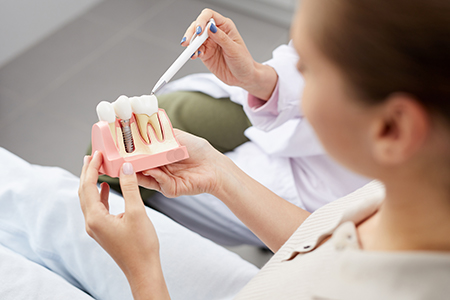We speak English, Spanish and Portuguese
We speak English, Spanish and Portuguese

Missing teeth can affect more than just your smile — they influence how you eat, how you speak, and how your facial structure is supported. Modern dental implants provide a predictable, long-term solution that restores both form and function. Unlike older removable options, implants act as artificial tooth roots that anchor restorations securely and preserve the surrounding bone.

Dental implants are engineered to integrate with jawbone, offering stability that closely mimics natural teeth. That stability translates into everyday benefits: clearer speech, improved chewing efficiency, and a natural appearance that enhances confidence. For many patients, implants feel and function more like their own teeth than any other replacement option.
Deciding on implant therapy starts with a careful evaluation of your oral health, bone volume, and overall medical history. A collaborative approach — where clinicians explain options clearly and tailor care to each patient’s lifestyle and goals — leads to better outcomes and higher patient satisfaction.
At the core of every implant system is a small, biocompatible post — most commonly made from titanium or titanium alloys — that is placed into the jawbone. Over the following months, bone naturally bonds to the implant in a process called osseointegration. Once integrated, the implant serves as a reliable foundation for a crown, bridge, or denture crafted to match the shape, color, and function of the surrounding teeth.
Manufacturers and clinicians use a range of prosthetic materials to reproduce natural tooth anatomy, including ceramic and zirconia for crowns that blend seamlessly with adjacent teeth. These materials are chosen for strength, wear resistance, and aesthetic quality so that the finished result looks natural and performs well under daily use.
Contemporary implant care relies on careful planning — utilizing digital imaging and thorough clinical exams to determine the optimal position and angulation for each implant. This planning helps protect adjacent teeth and anatomical structures, optimizes prosthetic outcomes, and reduces surprises during surgery. Clear communication between you and your dental team ensures that the final restoration meets both functional needs and aesthetic expectations.
Implants are popular because they deliver lasting improvements to how patients live day to day. By restoring tooth roots as well as crowns, implants help maintain the jawbone and facial contour, reduce the risk of neighboring teeth shifting, and provide a secure chewing surface without the adhesive or movement that can come with removable prostheses.
Because implants are stable and fixed in the mouth, they make it easier to enjoy a balanced diet, speak without concern for slippage, and smile naturally in social situations. For many people, these functional gains translate into improved self-confidence and quality of life.

Implant therapy is not one-size-fits-all. Treatment can range from a single-tooth replacement to implant-supported bridges or full-arch restorations that replace an entire upper or lower dental arch. Your care plan will be shaped by the number of missing teeth, bone quality, aesthetic goals, and how quickly you need function restored.
Modern techniques allow clinicians to place implants in strategic positions to support several replacement teeth while minimizing surgical complexity. For patients who need a full arch of teeth, options include fixed restorations supported by four to six implants, or removable overdentures that attach to fewer implants for added stability.
Each of these options carries distinct advantages that should be discussed during your consultation so the chosen approach aligns with your expectations for function, aesthetics, and maintenance.
Many adults are suitable candidates for implant therapy. Key considerations include overall health, oral hygiene, and adequate bone to support the implant. When bone volume is limited, bone grafting procedures or sinus elevation can create the necessary foundation. A careful medical and dental evaluation helps determine candidacy and any preparatory care needed before implants are placed.
Placing an implant is typically performed as an outpatient procedure under local anesthesia, with sedation options available when appropriate. After placement, the healing period allows the implant to integrate with surrounding bone. During this time, temporary restorations may be used until the implant is stable enough to support the final prosthesis.

Bone grafting is a common adjunctive procedure when prior tooth loss or periodontal issues have reduced bone volume. Grafting restores the bone profile so implants can be placed in a stable, long-lasting position. Materials and techniques vary, and your clinician will explain what is most suitable for your specific needs.
Long-term success depends on routine care. Regular dental exams, professional cleanings, and consistent home hygiene help prevent complications such as peri-implant inflammation. With attentive maintenance and timely follow-up, implants offer an enduring solution that supports oral health and preserves the appearance of your smile.
Dental implants offer a practical, well-proven path to restoring missing teeth with results that feel natural and support long-term oral health. Whether you are considering a single implant or a comprehensive full-arch restoration, an individualized treatment plan ensures the approach matches your goals and clinical needs.
Our team brings experience, modern technology, and a patient-centered process to every implant case. At Inspirational Smiles, we focus on clear communication and careful planning so each patient knows what to expect at every stage of care.
If you'd like to learn more about implant dentistry or discuss whether implants are right for you, please contact us for more information. We’re here to answer your questions and help you explore the best options for rebuilding a healthy, confident smile.

If you've lost a tooth due to injury, decay, gum disease, or any other reason, we recommend dental implants to replace missing teeth. Dental implants come the closest to replicating the look, feel, and function of your natural teeth.
Dental implants are placed into the jawbone and mirror the same function as the root of a tooth. The procedure for dental implants is usually performed while a patient is sedated. Patients who undergo IV sedation must have an empty stomach and transportation home following the procedure. Most sedation patients will have little to no memory of the procedure occurring.
Generally, dental implants are made out of a biocompatible metal such as titanium. Biocompatible metals are also used for other common bone implants (such as shoulder, hip, and knee replacements). The visible portion of the implant is usually made out of porcelain and is custom-made to match your existing teeth.
Dental implants are designed to fuse to the bone, which makes them become permanent fixtures. Typically speaking, the success rate is nearly 100%. There are few cases in which the implant will not fuse as intended and must be removed. If this happens to occur, the procedure can be attempted again a few months later.
Dental implants are not usually covered by dental insurance, but may be covered under a patient's medical insurance. Our office and your insurance company can discuss coverage options with you based on your individual case and treatment plan.
It's easy... just take care of an implant as if it's a natural tooth! This involves regular brushing, flossing, and dental checkups. If you have any concerns about your implant, contact us immediately.

Looking to schedule your next dental visit or learn more about our services?
Getting in touch with Inspirational Smiles is simple! Our caring team is ready to help with appointment scheduling, questions about treatments, or any concerns you may have. You can call us or use our easy online contact form—whatever works best for you.
Take the first step toward a healthier, more confident smile today and experience the difference that personalized, compassionate dental care can make.